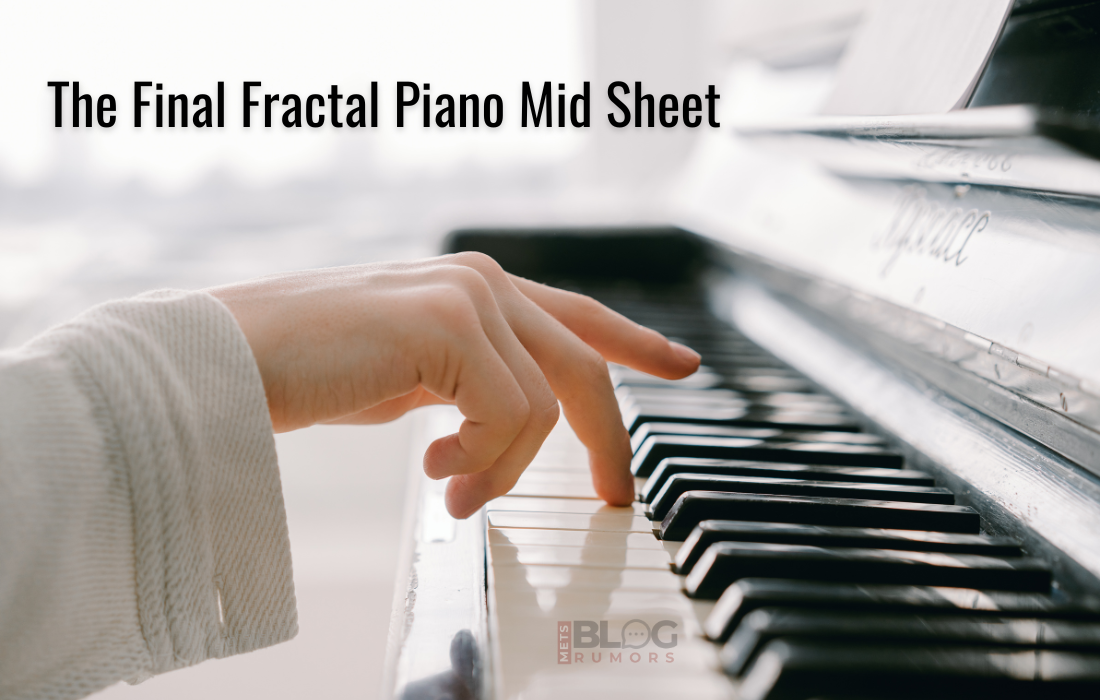The final fractal piano mid sheet composition merges mathematical beauty with musical complexity. This work takes inspiration from fractals—geometric patterns that repeat at every scale—and translates their intricacy into a soundscape that challenges both the ear and the performer. The fractal nature of this composition is revealed in its structure, harmonics, and rhythm, as each segment mirrors the others in subtle and sometimes unexpected ways. It can captivate listeners with its unconventional melodic patterns, which loop and spiral as if the music itself is folding back into itself. Despite its complexity, the piece is deeply rewarding for musicians who are willing to delve into its nuances.
One of the distinguishing aspects of the final fractal piano mid sheet is its mid-sheet, which serves as a critical moment in the piece’s development. The mid-sheet acts as a bridge between the more straightforward introduction and the intricate finale. In the mid-sheet, the core themes and ideas are fully explored, allowing the player to experiment with phrasing, dynamics, and tempo.
This guide aims to explore the mid-sheet of The the final fractal piano mid sheet in detail, offering insights into its key elements, structure, and strategies for mastering its performance. By the end of this guide, you will have a thorough understanding of how to approach this technically demanding yet musically fulfilling composition.
Overview of the Mid Sheet for The the final fractal piano mid sheet
The mid-sheet of the final fractal piano mid sheet offers a rich tapestry of musical ideas that showcase the composer’s ability to manipulate fractal concepts within a musical framework. It is neither a climax nor a conclusion but rather a point where themes coalesce and intensify before cascading into the final section. In terms of structure, the mid-sheet alternates between intricate passages and brief moments of simplicity, creating a compelling contrast that pulls the listener deeper into the music.
One of the defining features of the mid-sheet is its use of recurring motifs that appear throughout the composition, varying slightly in each iteration. This sense of recurrence adds a cyclical nature to the music, much like the self-repeating patterns seen in fractals. However, unlike traditional musical repetition, the variations in the motifs often play with expectations, creating a sense of both familiarity and surprise.
In terms of notation, the mid-sheet can appear overwhelming at first glance. The abundance of dynamic markings, tempo changes, and ornamentations demands careful attention from the performer. However, with the right approach, the mid-sheet reveals itself as a series of smaller, interconnected sections that can be mastered individually.
Examining the Key Signature and Time Signature
The key signature of The final fractal piano mid sheet is in the key of D minor, a key that evokes a sombre and reflective mood. D minor is often associated with introspection and depth, which complements the complex, almost philosophical nature of the piece. The use of D minor sets the tone for a composition that requires emotional investment from the performer, as it is not just the technical execution that matters, but the ability to convey the depth of feeling embedded within the notes.
The time signature shifts frequently throughout the mid-sheet. The initial section begins in 6/8 time, which gives the music a flowing, almost dance-like quality, but this soon gives way to more complex time signatures, including 5/4 and 7/8. These irregular time signatures add to the fractal-like nature of the piece, as they break up the flow of the music in unpredictable ways, keeping both the performer and the listener on edge.
The frequent time signature changes can be one of the most challenging aspects of performing the mid-sheet. It is essential to develop an internal sense of rhythm that allows you to transition seamlessly between different meters without disrupting the overall flow of the piece. Practising with a metronome set to subdivisions of the beat can help in mastering these transitions.
Breaking Down the Melodic Contour and Phrasing
The melodic contour of the mid-sheet is one of its most distinctive features. The lines ascend and descend in an almost wave-like pattern, echoing the self-replicating structures found in fractals. The melodies are not always straightforward; they often twist and turn unexpectedly, creating a sense of tension and release that mirrors the fractal patterns. These melodic lines are not just visually striking on the sheet music but are also designed to evoke a sense of infinity when played as if the melody could continue indefinitely.
In terms of phrasing, the mid-sheet is filled with long, arching lines that require careful attention to breath and timing. The phrasing is not always intuitive, which can make it difficult for the performer to know where to place emphasis. However, the key to mastering the phrasing is to think of each phrase as part of a larger structure. Much like the smaller segments of a fractal contribute to the overall pattern, each phrase in the mid-sheet contributes to the overarching musical narrative.
Breathing and pacing are critical here. A common mistake is to rush through the phrases, especially in the more technically demanding sections. Instead, try to take your time with each phrase, allowing the music to unfold naturally. Marking the breathing points in your sheet music can help in maintaining control over the phrasing.
Analyzing the Chords and Harmonic Structure
The harmonic structure of The the final fractal piano mid sheet is as intricate as its melodic lines. The mid-sheet features a blend of traditional chords and more dissonant, modern harmonies that challenge conventional harmonic expectations. At its core, the harmonic structure is based on a series of repeating chord progressions, but these progressions are frequently interrupted by unexpected harmonic shifts.
In D minor, the chords primarily revolve around minor triads, but there are frequent uses of diminished and augmented chords that create a sense of unease. The use of diminished chords, in particular, gives the piece a haunting quality, as these chords are unresolved and create a feeling of instability.
One of the most interesting aspects of the harmonic structure is the way it mirrors the fractal nature of the composition. Just as the melodic lines repeat and evolve, so too do the chord progressions. Each iteration of the chord progression brings slight changes, whether it’s an added dissonance or an unexpected resolution, which creates a sense of growth and evolution in the harmony.
Understanding the Rhythmic Patterns and Syncopation
The rhythmic patterns in the mid-sheet of The the final fractal piano mid sheet are complex and varied. The frequent time signature changes create a rhythmic fluidity that is both challenging and rewarding for the performer. One of the key rhythmic features is the use of syncopation, where the emphasis is placed on the off-beats rather than the strong beats. This syncopation adds to the unpredictability of the music, making it feel as though the rhythms are constantly shifting and evolving.
The rhythmic patterns often mimic the fractal-like structure of the composition. Short rhythmic motifs are repeated and developed throughout the mid-sheet, much like the recurring patterns in a fractal. These rhythmic motifs serve as the backbone of the piece, providing a sense of continuity even as the music becomes more complex.
To master the rhythmic patterns, it is important to practice slowly at first, focusing on accuracy and precision. Using a metronome can help keep a steady tempo, especially during the more syncopated sections. Once you are comfortable with the rhythms, you can gradually increase the tempo and work on incorporating the dynamics and articulation.
Interpreting the Dynamic Markings and Articulation
The dynamic markings in the mid-sheet of The the final fractal piano mid sheet are essential to conveying the emotional depth of the piece. The dynamics range from the softest pianissimo to the loudest fortissimo, with frequent crescendos and decrescendos that create a sense of ebb and flow. These dynamic shifts are often sudden and dramatic, which adds to the tension and intensity of the music.
In addition to the dynamic markings, there are numerous articulation markings that provide further insight into how the music should be played. The articulation varies from legato, where the notes are played smoothly and connected, to staccato, where the notes are played short and detached. These contrasting articulations help to create a sense of texture and depth in the music.
Interpreting the dynamic markings requires careful attention to the overall structure of the piece. The dynamics are not just about volume; they are about shaping the music and creating contrasts between different sections. Pay attention to the emotional arc of the piece and use the dynamics to highlight key moments in the music.
Tips for Practicing the Mid Sheet
Mastering the mid-sheet of The the final fractal piano mid sheet requires patience, dedication, and a methodical approach. Here are some tips for practising this challenging section:
- Divide and conquer: The mid-sheet is filled with complex sections that can be overwhelming if approached all at once. Break the piece down into smaller sections and focus on mastering each one individually before moving on to the next. This will help you build confidence and ensure that you are fully comfortable with each part of the music.
- Focus on accuracy: In a piece as intricate as this, accuracy is key. Take your time to ensure that you are playing each note correctly, especially in the more complex rhythmic and harmonic passages. It is better to play slowly and accurately than to rush through the music and make mistakes.
- Use a metronome: A metronome can be an invaluable tool for keeping a steady tempo, especially during sections with frequent time signature changes and syncopated rhythms. Start by practising with a slow tempo and gradually increase the speed as you become more comfortable with the music.
- Pay attention to dynamics and articulation: The dynamic and articulation markings are essential to bringing the music to life. Make sure to incorporate these elements into your practice from the beginning, as they are crucial to the overall interpretation of the piece.
- Practice hands separately: The mid-sheet features complex hand coordination, especially in the sections with intricate rhythmic patterns. Practising each hand separately can help you focus on the individual lines and ensure you are playing them accurately before putting them together.
- Stay relaxed: The technical demands of the mid-sheet can lead to tension, especially in the hands and arms. Make sure to stay relaxed and avoid gripping the keys too tightly. Taking frequent breaks and practising good posture can help prevent fatigue and injury.
Conclusion
The the final fractal piano mid sheet mid-sheet is a masterpiece that challenges both the intellect and the emotions. Its complexity, with shifting time signatures, intricate melodies, and evolving harmonic structures, requires not just technical skill but a deep understanding of its underlying concepts. By breaking down the piece into manageable sections and focusing on accuracy, phrasing, and dynamics, you can unlock the beauty and intricacy of this unique composition. Whether you are preparing to perform the piece or simply studying it for personal growth, The the final fractal piano mid sheet offers a profound musical journey that rewards careful study and thoughtful interpretation.





